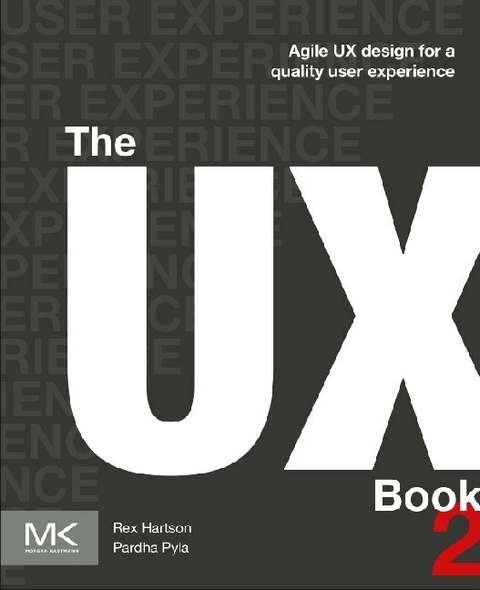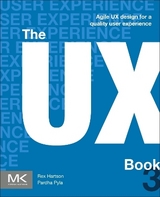
The UX Book
Morgan Kaufmann Publishers In (Verlag)
978-0-12-805342-3 (ISBN)
One of the major positive trends in UX is the continued emphasis on design—a kind of design that highlights the designer’s creative skills and insights and embodies a synthesis of technology with usability, usefulness, aesthetics, and meaningfulness to the user. In this edition a new conceptual top-down design framework is introduced to help readers with this evolution.
This entire edition is oriented toward an agile UX lifecycle process, explained in the funnel model of agile UX, as a better match to the now de facto standard agile approach to software engineering. To reflect these trends, even the subtitle of the book is changed to "Agile UX design for a quality user experience".
Designed as a how-to-do-it handbook and field guide for UX professionals and a textbook for aspiring students, the book is accompanied by in-class exercises and team projects.
The approach is practical rather than formal or theoretical. The primary goal is still to imbue an understanding of what a good user experience is and how to achieve it. To better serve this, processes, methods, and techniques are introduced early to establish process-related concepts as context for discussion in later chapters.
Rex Hartson is a pioneer researcher, teacher, and practitioner-consultant in HCI and UX. He is the founding faculty member of HCI (in 1979) in the Department of Computer Science at Virginia Tech. With Deborah Hix, he was co-author of one of the first books to emphasize the usability engineering process, Developing user interfaces: Ensuring usability through product & process. Hartson has been principle investigator or co-PI at Virginia Tech on a large number of research grants and has published many journal articles, conference papers, and book chapters. He has presented many tutorials, invited lectures, workshops, seminars, and international talks. He was editor or co-editor for Advances in Human-Computer Interaction, Volumes 1-4, Ablex Publishing Co., Norwood, NJ. His HCI practice is grounded in over 30 years of consulting and user experience engineering training for dozens of clients in business, industry, government, and the military.
Pardha Pyla is an award-winning designer and product strategist with deep expertise in envisioning and delivering industry-leading products. He is the founding member of multiple thriving product and design (UX) practices that were responsible for producing successful enterprise software solutions in use across many industries. He is a pioneering researcher in the area of coordinating software engineering and UX lifecycle processes and the author of several peer-reviewed research publications in human-computer interaction and software engineering. He has received numerous awards in recognition of his work in design thinking, research, teaching, leadership, and service.
PART 1. INTRODUCTION
1. What is UX and UX design?
2. The Wheel: UX processes, lifecycles, methods, and technique
3. Scope, rigor, complexity, and project perspectives
4. Agile lifecycle processes and the Funnel Model of Agile UX
5. Prelude to the process chapters
6. Background: Introduction
PART 2. UNDERSTAND NEEDS
7. Usage research data elicitation
8. Usage research data analysis
9. Usage research data modeling
10. UX design requirements: User stories and requirements
11. Background: Understand Needs
PART 3. DESIGN SOLUTIONS
12. The nature of UX design
13. Bottom-up vs. top-down design
14. Generative design: Ideation, sketching, and critiquing
15. Mental models and conceptual design
16. Designing the ecology and a pervasive information architecture
17. Designing the interaction
18. Designing for emotional impact
19. Background: Design
PART 4. PROTOTYPE CANDIDATES
20. Prototyping
PART 5. EVALUATE UX
21. UX evaluation methods and techniques
22. UX evaluation: UX goals, metrics, and targets
23. Preparation for empirical UX evaluation
24. Empirical data collection methods and techniques
25. Analytical data collection methods and techniques
26. UX Evaluation: Data analysis
27. UX evaluation: Reporting results
28. Background: UX evaluation
PART 6. AGILE UX AND CONNECTIONS TO AGILE SE
29. Connecting agile UX with agile software development
30. Background: Agile connections
PART 7. AFFORDANCES AND DESIGN GUIDELINES
31. Affordances in UX design
32. The interaction cycle
33. UX design guidelines
34. Background: Affordances and UX design principles
| Erscheinungsdatum | 14.01.2019 |
|---|---|
| Verlagsort | San Francisco |
| Sprache | englisch |
| Maße | 191 x 235 mm |
| Gewicht | 1790 g |
| Themenwelt | Informatik ► Software Entwicklung ► User Interfaces (HCI) |
| ISBN-10 | 0-12-805342-9 / 0128053429 |
| ISBN-13 | 978-0-12-805342-3 / 9780128053423 |
| Zustand | Neuware |
| Haben Sie eine Frage zum Produkt? |
aus dem Bereich



